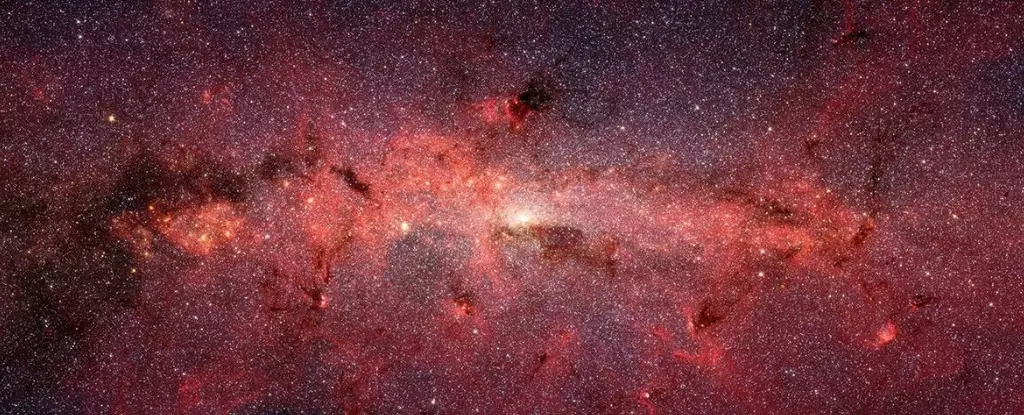Astronomers have long grappled with the enigmatic phenomena reigning at the heart of our galaxy, the Milky Way. The intricate dance of stars, gas, and cosmic forces in this vast expanse has led to some of the most intriguing and perplexing observations known to science. Among these, two particularly captivating mysteries stand out: the unexpectedly high ionization rates in the central molecular zone (CMZ) and the elusive gamma-ray emission of 511 kilo-electronvolts (keV). Both observations hint at something profound lurking beneath the surface of cosmic understanding, begging the question: Could they be the manifestations of a single mysterious source?
In the CMZ, spanning an astonishing 700 light-years, the conditions are far from serene. This region, densely packed with molecular gas, seems to behave erratically, with hydrogen molecules losing their electrons at rates that surpass current theoretical predictions. As scientists probe deeper into these anomalies, the intrigue grows. Can cosmic rays, starlight, or other known phenomena account for these sudden eruptions of ionization, or is something else at play?
Dark Matter: The Invisible Culprit?
As if by design, dark matter enters the narrative, a secretive character in the cosmic play that constitutes about 85% of the universe’s total matter. Its presence is inferred from its gravitational effects, yet its true nature remains one of the greatest riddles in contemporary astrophysics. A compelling hypothesis that often flies under the radar is that dark matter particles could be lightweight entities, spinning within the range of a few million electronvolts—sub-GeV dark matter candidates, to be precise.
What if these hypothetical particles, upon encountering their antiparticles, annihilate each other in the dense heart of the CMZ, leading to an explosion of electrons and positrons? Such a process could directly contribute to the notable ionization rates observed, effectively linking the two cosmic enigmas. The sheer density of the CMZ would ensure that the resulting particles deposit their energy immediately, creating a local form of ionization that aligns intriguingly with observed data.
A Symbiotic Relationship Between Forces
Recent research that marries simulation with tantalizing observations poses a radical proposition: The phenomena observed in the CMZ concerning ionization and the distinctive glow of gamma rays at 511 keV may not merely coexist but could be fundamentally intertwined. The positrons produced from dark matter annihilation have the potential to gradually slow down, leading to their interaction with ambient electrons and generating the gamma-ray emissions that have mystified scientists since their first detection in the 1970s.
The correlation between the creation of positrons and the ionization of hydrogen introduces the notion of a cosmic symbiosis—each aspect feeding into the vitality of the other. This connection is not merely theoretical; it echoes through the fabric of space-time, promising a deeper understanding of dark matter’s role in the universe.
Granular Evidence in Galactic Patterns
The simulations derived from these hypotheses indicate that the predicted ionization profile generated by dark matter is notably flatter compared to what one would expect from point sources such as black holes or cosmic rays. This uniformity in ionization distribution provides a tantalizing hint that the underlying force may be more complex than traditional astrophysics has led us to believe.
Furthermore, future advancements in observational technology stand to illuminate the correlation between 511 keV emissions and ionization rates even further. As telescopes become more adept at capturing intricate cosmic details, the CMZ could yield invaluable data about dark matter, propelling our quest for knowledge into uncharted territories.
A New Perspective on Cosmic Events
This revelation from our galactic core is a critical example of how modern science must pivot towards integrated approaches, exploring interdisciplinary avenues combining observational astronomy with theoretical models. The pursuit of unraveling dark matter’s secrets requires an openness to innovative ideas—a willingness to embrace the bizarre and rethink the foundational principles governing our understanding of the cosmos.
As we stand on the precipice of new discoveries, it is clear that the mysteries of our galaxy’s core remind us of the unyielding spirit of inquiry that defines human nature. Listening to the silent whispers of dark matter, we might find not only answers to the lingering questions surrounding ionization and gamma-ray emissions but also a broader understanding of the universe’s enigmatic building blocks. The quest to decode this cosmic language is made all the more thrilling by the prospect of uncovering new dimensions of reality, hidden within the very fabric of the universe.


Leave a Reply